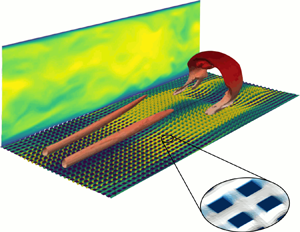Crossref Citations
This article has been cited by the following publications. This list is generated based on data provided by
Crossref.
Cherubini, Stefania
Picella, Francesco
and
Robinet, Jean-Christophe
2020.
Variational Nonlinear Optimization in Fluid Dynamics: The Case of a Channel Flow with Superhydrophobic Walls.
Mathematics,
Vol. 9,
Issue. 1,
p.
53.
Castagna, Marco
Mazellier, Nicolas
and
Kourta, Azeddine
2021.
On the onset of instability in the wake of super-hydrophobic spheres.
International Journal of Heat and Fluid Flow,
Vol. 87,
Issue. ,
p.
108709.
Jafarimoghaddam, A.
Roşca, N.C.
Roşca, A.V.
and
Pop, I.
2021.
The universal Blasius problem: New results by Duan–Rach Adomian Decomposition Method with Jafarimoghaddam contraction mapping theorem and numerical solutions.
Mathematics and Computers in Simulation,
Vol. 187,
Issue. ,
p.
60.
Zhai, Haoyu
Torres, Juan F.
Zhao, Yongling
and
Xu, Feng
2021.
Transition from steady to chaotic flow of natural convection on a section-triangular roof.
Physical Review Fluids,
Vol. 6,
Issue. 1,
Tomlinson, Samuel D.
and
Papageorgiou, Demetrios T.
2022.
Linear instability of lid- and pressure-driven flows in channels textured with longitudinal superhydrophobic grooves.
Journal of Fluid Mechanics,
Vol. 932,
Issue. ,
Zhai, Xueyan
Chen, Kaiwen
and
Song, Baofang
2023.
Linear instability of channel flow with microgroove-type anisotropic superhydrophobic walls.
Physical Review Fluids,
Vol. 8,
Issue. 2,
Rahmani, H.
Kumar, H.
Greener, J.
and
Taghavi, S. M.
2023.
Yield stress fluid flows in superhydrophobic channels: From creeping to inertial regime.
Physics of Fluids,
Vol. 35,
Issue. 8,
Nobis, Harrison
Schlatter, Philipp
Wadbro, Eddie
Berggren, Martin
and
Henningson, Dan S.
2023.
Modal laminar–turbulent transition delay by means of topology optimization of superhydrophobic surfaces.
Computer Methods in Applied Mechanics and Engineering,
Vol. 403,
Issue. ,
p.
115721.
Gluzdov, D. S.
and
Gatapova, E. Ya.
2023.
Microchannel Surface Structures for Drag Reduction.
Journal of Engineering Thermophysics,
Vol. 32,
Issue. 2,
p.
214.
Dogan, Bekir
Ozbey, Mustafa
Namli, Lutfu
and
Aybek, Unsal
2023.
Numerical simulation of slip behaviors and friction reduction effects in hydrophobic micro-channel in laminar flow conditions.
Thermal Science,
Vol. 27,
Issue. 4 Part B,
p.
3405.
Nobis, Harrison
Schlatter, Philipp
Wadbro, Eddie
Berggren, Martin
and
Henningson, Dan S.
2023.
Topology optimization of Superhydrophobic Surfaces to delay spatially developing modal laminar–turbulent transition.
International Journal of Heat and Fluid Flow,
Vol. 104,
Issue. ,
p.
109231.
Rahmani, H.
and
Taghavi, S.M.
2023.
Viscoplastic flows in thin superhydrophobic channels.
Journal of Non-Newtonian Fluid Mechanics,
Vol. 315,
Issue. ,
p.
105016.
Zhu, Manfu
Huang, Weixi
Ma, Liran
and
Luo, Jianbin
2024.
Influence of surface slip on hydrodynamics and flow field around a two-dimensional hydrofoil at a moderate Reynolds number.
Physics of Fluids,
Vol. 36,
Issue. 5,
Jouin, A.
Cherubini, S.
and
Robinet, J.C.
2024.
Turbulent transition in a channel with superhydrophobic walls: anisotropic slip and shear misalignment effects.
Journal of Fluid Mechanics,
Vol. 980,
Issue. ,
Liu, Bin
Zhang, Yongming
and
Liu, Jianhua
2024.
Influence of bow shape and model scale on the natural transition in boundary layers on underwater axisymmetric bodies with a superhydrophobic surface.
Physics of Fluids,
Vol. 36,
Issue. 7,
Cui, Jianzhong
and
Tang, Hui
2024.
A review on flow instability in hydro-viscous drive.
Physics of Fluids,
Vol. 36,
Issue. 4,
Jouin, A.
Robinet, J.C.
and
Cherubini, S.
2024.
Stability of the flow over superhydrophobic micro roughnesses: The influence of the interface.
International Journal of Thermofluids,
Vol. 23,
Issue. ,
p.
100707.
Jouin, Antoine
Ciola, Nicola
Cherubini, Stefania
and
Robinet, Jean Christophe
2024.
Detuned secondary instabilities in three-dimensional boundary-layer flow.
Physical Review Fluids,
Vol. 9,
Issue. 4,
Zhang, Liheng
Zhai, Xueyan
Song, Baofang
and
Wang, Yaohong
2024.
Stability of plane Couette flow under anisotropic superhydrophobic effects.
Physics of Fluids,
Vol. 36,
Issue. 7,
Ceccacci, Silvia
Calabretto, Sophie A. W.
Thomas, Christian
and
Denier, James P.
2024.
Dynamics and control of separated flow over small-scale surface deformations with slip.
Physical Review Fluids,
Vol. 9,
Issue. 3,



